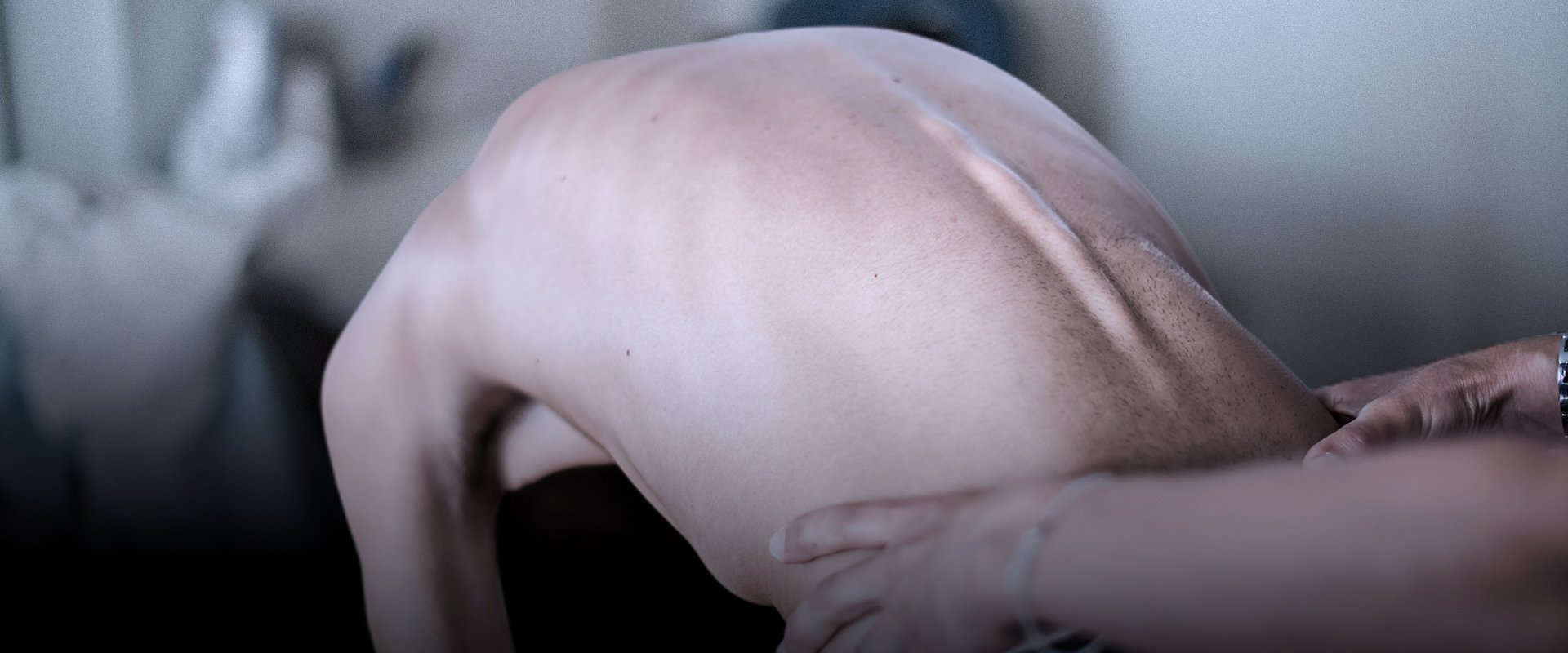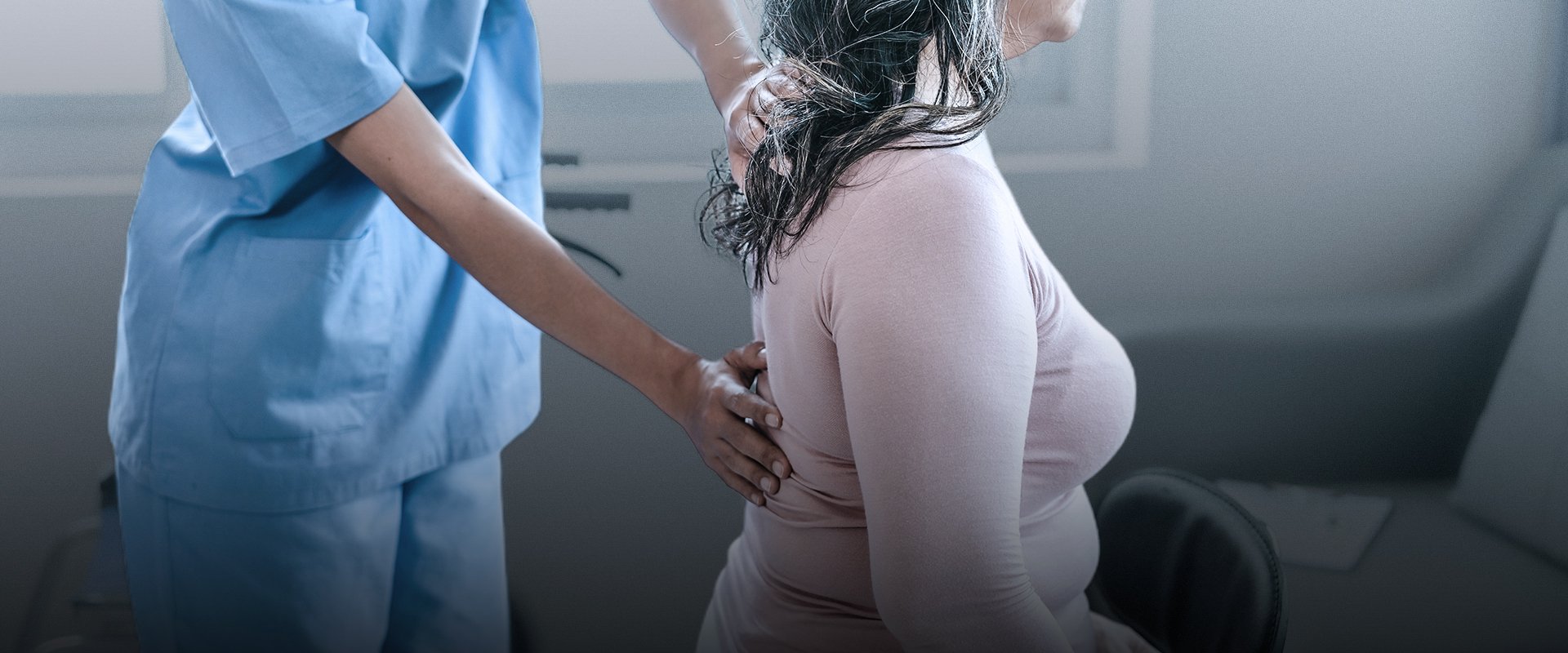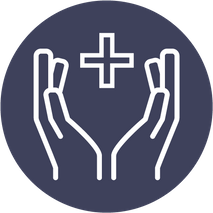
Physical therapy for dowager's hump
AT EVOLVE
Physical therapy for dowager's hump
HOW CAN PHYSICAL THERAPY HELP A DOWAGER’S HUMP
A dowager’s hump is what some people call the increased curvature of the upper back most often seen in older adults. Clinically known as thoracic hyperkyphosis, a dowager’s hump is more than just an aesthetic issue, it can have significant impacts on function and quality of life. Physical therapy interventions can have a modest effect on spinal curvature, improve symptoms and help prevent curve progression.
WHAT DOES PHYSICAL THERAPY FOR A DOWAGER’S HUMP LOOK LIKE?
Physical therapy for a dowager’s hump is aimed at strengthening the muscles that hold your posture upright, improving postural habits, increasing spinal mobility, reducing pain and managing the effects of this condition on daily life. Your physical therapist will likely use hands-on manual therapy techniques to treat muscles and joints while prescribing exercises for you to perform at home and in the clinic.
WHAT IS A DOWAGER’S HUMP?
Dowager’s hump is what some people use to refer to a visible bump or rounding near the top of the spine between the shoulders. Most often seen in older adults, a dowager’s hump is actually the result of changes in the curvature of the spine. Your spine can be broken down into three main segments. The cervical spine consists of seven vertebrae that make up your neck. In healthy spines, the cervical spine curves forward creating an arch at the back of the neck. This is called lordosis. Beneath the cervical spine lies the thoracic spine. This part of the spine attaches to the rib cage and consists of twelve vertebrae. Unlike the neck, the thoracic spine curves slightly backwards, a curvature known as kyphosis. Finally, your lumbar spine makes up the lower back and is where the last of five lumbar vertebrae connect to the sacrum, a broad, shovel-shaped bone that connects the spine to the lower extremities through the pelvis. The lumbar spine normally has a lordotic curve just like the neck.
Changes to spinal curvature can exaggerate or reduce the normal lordotic and kyphotic spinal curvature. An increase in the kyphosis or rounding of the thoracic spine, a condition called thoracic hyperkyphosis, can create the appearance of a hump between the shoulder blades. Many call this increased curvature a dowager’s hump. Historically, the word dowager referred to a dignified older woman or a widow. Because thoracic hyperkyphosis was more common in older women than men, the term dowager’s hump was coined to describe the appearance of this condition.
WHAT CAUSES THIS CONDITION?
Thoracic hyperkyphosis can have many causes:
- Age-related changes in the spine
- Postural changes from poor posture, weak muscles and ligaments
- Congenital hyperkyphosis: bony defect present at birth
- Scheurmann’s disease in juveniles
The degree of kyphosis is quantified by a kyphosis angle. If you have a kyphosis angle greater than 40 degrees, you may be diagnosed with thoracic hyperkyphosis. In many cases, thoracic kyphosis will worsen without intervention. Age-related thoracic hyperkyphosis affects 20-40% of older adults. The following causes are associated with the development of this condition:
- Weakness in the muscles that extend the spine
- Changes in the strength and tautness of spinal ligaments
- Loss of intervertebral disc height
- Poor posture
- Changes in the sensory systems that cue upright posture
SYMPTOMS AND EFFECTS OF A DOWAGER’S HUMP
Many people with a dowager’s hump are bothered by its appearance but the impact of increased spinal curvature can extend beyond appearances. If you have a dowager’s hump you might experience the following:
- Back or neck pain
- Numbness, tingling or radiating pain into the upper extremities or buttock area
- Breathing difficulties due to changes in rib cage mobility
- Changes in walking and balance which can lead to falls
- Increased risk of developing vertebral fractures due to increased stress on the bones
- Decreased overall functioning and ability to participate in activities of daily living
End Injury Progression
Physical therapy for Dowager's hump has proven to prevent injury, slow and even stop pain issues, improve performance, and reverse injury progression in many cases.
Relieve Pain
The movements used in this technique can target your entire body helping you to manage discomfort and pain during the course of your physical therapy treatments.
Improve Range of Motion
Posture awareness is an important area to focus on due to the fact that certain positions may cause you further discomfort and pain.
Restore Mobility
You can regain mobility and flexibility by taking part in the stretches and exercises as prescribed by your physical therapist.
How Long Will Physical Therapy for Dowager’s Hump Last?
If you decide to work with a physical therapist to help with your Dowager's hump issues, your entire treatment plan could consist of around 8-20+ different physical therapy sessions that will each last 60-90 minutes. Once you complete your customized physical therapy treatment plan, you will be able to continue to do the prescribed stretches and exercises utilized during your PT sessions yet in the comfort of your own home.
PHYSICAL THERAPY FOR A DOWAGER’S HUMP
Physical therapists often work with patients with thoracic hyperkyphosis. While most people would prefer to eliminate their dowager’s hump altogether, this is quite difficult and outside of surgical intervention, conservative treatment like physical therapy can have a moderate effect on thoracic hyperkyphosis. The goals of physical therapy for the management of a dowager’s hump include:
- Reduce pain
- Improve spinal extensor strength
- Improve posture
- Reduce the thoracic kyphosis angle
- Improve overall functional mobility
- Increase postural awareness
- Prevent vertebral fractures
- Slow or prevent the progression of the curve
While we will always individualize a treatment plan for your specific needs, the following interventions have been shown to have a positive effect on thoracic hyperkyphosis:
Massage: Both mechanical and manual massage of the spinal muscles can be beneficial
Spinal mobilization: mobilization of the spinal vertebrae can help with spinal mobility and alignment and can improve pain
Muscle energy techniques: muscle energy techniques use sustained muscle contractions against a counterforce to relax and lengthen the muscles and thus improve the position of the spine
Spinal extensor strengthening: exercises to strengthen the muscles that extend the spine and hold you upright are important in reducing and preventing the progression of thoracic hyperkyphosis
Stretching: stretching, especially of anterior muscles that can exaggerate spinal kyphosis can be helpful
Pain management: pain management tools including massage, TENS, electrical stimulation, ice and heat can be used to reduce discomfort
Gait and balance training: gait and balance training can be helpful to offset the effects of thoracic hyperkyphosis on mobility
The time to start treating a dowager’s hump is now. Early intervention is the key to minimizing the effects of this condition and maximizing the effectiveness of physical therapy. If you are living with a dowager’s hump and ready to take action, call Evolve Physical Therapy today to schedule your initial evaluation.
References:
Jung, S. H., Hwang, U. J., Ahn, S. H., Kim, J. H., & Kwon, O. Y. (2020). Effects of Manual Therapy and Mechanical Massage on Spinal Alignment, Extension Range of Motion, Back Extensor Electromyographic Activity, and Thoracic Extension Strength in Individuals with Thoracic Hyperkyphosis: A Randomized Controlled Trial. Evidence-based complementary and alternative medicine : eCAM, 2020, 6526935. https://doi.org/10.1155/2020/6526935
Jung, S. H., Hwang, U. J., Kim, J. H., Gwak, G. T., & Kwon, O. Y. (2022). Effect of improved thoracic kyphosis on forward shoulder posture after mobilization in individuals with thoracic hyperkyphosis. Clinical biomechanics (Bristol, Avon), 97, 105707. https://doi.org/10.1016/j.clinbiomech.2022.105707
Roghani, T., Allen, D. D., Gladin, A., Rahimi, A., Mehrabi, M., Rezaeian, Z. S., Farajzadegan, Z., & Katzman, W. B. (2024). The Association Between Physical Function and Hyperkyphosis in Older Females: A Systematic Review and Meta-analysis. Journal of geriatric physical therapy (2001), 47(2), 85–96. https://doi.org/10.1519/JPT.0000000000000371
Mill Basin (located in Harbor Fitness)
6161 Strickland Ave
Brooklyn, NY 11234
Monday: 7am-8pm
Tuesday: 7am-8pm
Wednesday: 8am-5pm
Thursday: 7am-8pm
Friday: 8am-1pm
Park Slope (located in Harbor Fitness)
550 5th Ave.
Brooklyn, NY 11215
Monday: 9am-8pm
Tuesday: 8am-6pm
Wednesday: 9am-8pm
Thursday: 8am-6pm
Friday: 8am-3pm
Gravesend
372 Avenue U
Brooklyn, NY 11223
Monday-Thursday: 8am-8pm
Friday: 8am-3pm
Kings Highway
945 Kings Highway
Brooklyn, NY 11223
Monday-Wed.: 12pm-8pm
Ready to take the next step to a healthier you?
Contact Us Today!
PHYSICAL THERAPY FOR DOWAGER’S HUMP
Need Physical therapy for Dowager’s Hump?
Let our caring and compassionate physical therapists help you with relieving pain while getting you back on your feet comfortably.
Call now to schedule your first PT consultation free of charge.
Call: 1-718-690-3229







